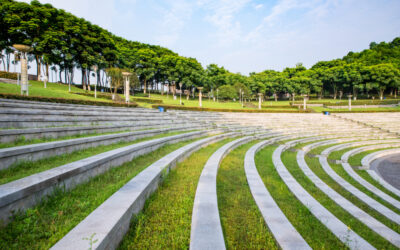As urban spaces become more constrained and the quest for greenery intensifies, Four Leaf Landscape has embraced the ancient yet ever-evolving concept of green walls to bring a slice of nature to the concrete jungle. The history of green walls, also known as living walls or vertical gardens, is a testament to humanity’s long-standing relationship with nature and our innovative efforts to integrate the natural world into our urban habitats.
The Roots of Vertical Greenery
The concept of green walls traces back to the Hanging Gardens of Babylon, one of the Seven Wonders of the Ancient World, where cascading terraces of flora reportedly adorned the palace of King Nebuchadnezzar II. This ancient marvel set a precedent for integrating vertical landscapes into architecture, showcasing the aesthetic and environmental benefits of vertical greenery.
In the modern era, the term “green wall” was possibly coined by Professor Stanley Hart White at the University of Illinois in 1938. His “vegetation-bearing architectonic structure” laid the groundwork for today’s living wall systems. However, it was not until the late 20th century that green walls began to gain momentum as part of sustainable design practices.
Four Leaf Landscape and the Green Wall Movement
At Four Leaf Landscape, we have studied the historical intricacies of green walls to design systems that not only enhance the visual appeal of urban spaces but also offer tangible environmental benefits. In Delhi’s dense urban environment, our green walls act as natural air filters, providing a respite from the city’s pollution. They are biodiversity hotspots, creating habitats for birds and insects amidst the urban sprawl.
Our approach to creating green walls is deeply rooted in sustainability. We utilize indigenous plants that thrive in India’s climate, reducing the need for excessive watering and maintenance. Our green walls are not just vertical gardens; they are symbols of our commitment to sustainable urban development.
The Future Is Vertical and Green
The history of green walls has shown us that as long as there are creative minds, the relationship between nature and architecture will continue to flourish. Four Leaf Landscape is at the forefront of this movement in India, driving innovation in green wall technology. We are constantly exploring new materials, irrigation techniques, and plant species to push the boundaries of what green walls can be.
The story of green walls is ongoing, and Four Leaf Landscape is writing its chapter with each project we undertake. Our green walls are more than just a nod to an ancient wonder; they are a step towards a greener, more sustainable future for all of us.
Conclusion
As we continue to build upon the rich history of green walls, Four Leaf Landscape remains dedicated to the vision of bringing more green spaces to urban India. We honor the past, innovate in the present, and dream of a future where our cities are alive with vertical forests that reach for the sky. Join us in this green revolution, as we turn walls into living legacies.




0 Comments